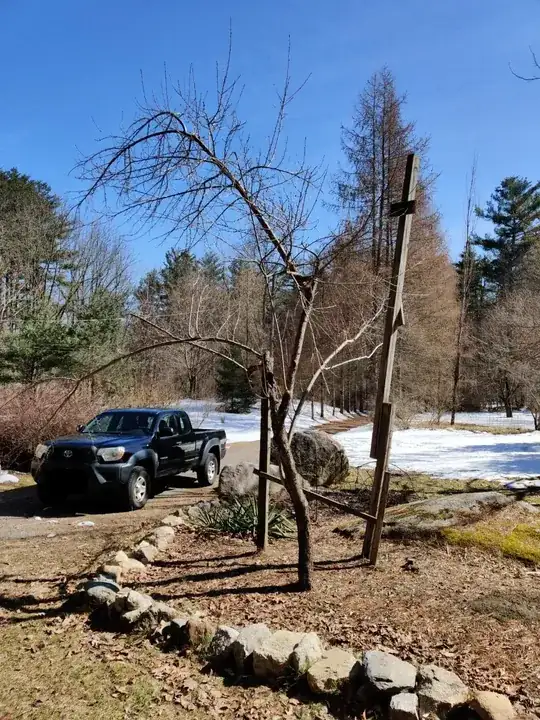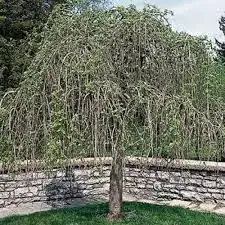I have this peach tree of unknown age, pictured below. It produces a lot of fruit, but all the branches need to be supported by tripods and thinned heavily. Is there any reasonable strategy for pruning it? All the guides I've seen recommend removing entire branches at junctions, but here removing any main branch would be a significant loss of mass
-
2I suspect that taking the "significant loss of mass" will be required to recover this to any reasonable shape, given the state it's in from past pruning. If you are looking to have less need of tripods, etc. you might consider setting up to espalier on heavy wire supported by sturdy posts, and training new growth onto that structure. – Ecnerwal Mar 12 '23 at 19:00
-
1@Ecnerwal, you should make it an answer. – Rohit Gupta Mar 12 '23 at 19:22
-
@Ecnerwal "espalier on heavy wire supported by sturdy posts" - Like, that mysterious structure immediately behind the tree? Thank you, maybe that should have been obvious but it was not. Also "without significant loss of mass" really meant "without killing it or rendering it unproductive for the rest of its life" - Assume your opinion is still that it's not feasible – jnj16180340 Mar 13 '23 at 23:06
-
2No, I think it is feasible, but it will take some intermediate setbacks to get there from where it is The structure behind the tree seems a bit small (width-wise) for an effective espalier of a tree that size, and wires are invisible to me in the photo if present. – Ecnerwal Mar 14 '23 at 02:30
2 Answers
When you are advised to take whole branches, the idea is to avoid leaving dead tips. That goes a little something like so. In the picture you see the cut is happening at the join with another branch. The result is you don't leave a dead tip.
Dead tips are a problem because they tend not to grow. So you get this unattractive and non-contributing stub with bark only on the towards-the-tree end. This leaves a place for fungus or insects to get in. And in locations with winter, it forms a place that ice can build up, possibly increasing the winter load and maybe breaking branches that could have avoided it.
If you trim back to the join with another branch, the bark will grow over the cut. If it's a larger branch it may leave a big scar. You may need to think about treating these to help the tree stay healthy. Your garden center may have advice on how to do that.
Contrast that with how some people trim a tree. They get the electric trimmer and basically do a "bowl cut" across the bottom of the tree. You often see this on mulberry trees. And it often means there are a bunch of dead tips poking out the bottom of the tree.
It does not mean you have to take any particular size of branch. You should do this right down to the smallest twig you remove. Always leave a growing tip on the parts you don't remove, and no dead tips on the part you cut. So there should be some leaf buds or leaves, depending on the time of year you are doing the trimming.
Start with removing any dead branches, as before right back to the living branch. Think about getting rid of tangled or overlapping branches that shade each other. Get an image in your mind how you want the tree to look. Decide which parts you want to remove.
Most trees will want to be pruned only during good strong growth so they can recover. And my own rule is to try not to take more than about 1/4 of the total "mass" of the tree. Your mileage may vary.
- 748
- 7
The "open center" is common method. Remove large branches in the center ( a few each year). This gets more light in the center and gives "a lower tree". I generally don't want to use a ladder to pick, so remove high branches. Also easier for any spraying. Remove "water sprouts" , vigorous new branches ; often growing straight up with few side branches. I found the state Ag department had many pamphlets on home gardening, etc ( IL.)
- 8,496
- 1
- 9
- 15


